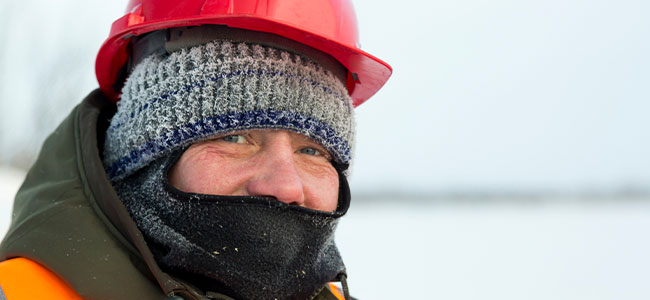
Training Employees to Handle Extreme Cold
Preparing employees for extremely cold conditions is essential for their health, safety, productivity and morale, requiring companies to invest in comprehensive training to mitigate health hazards.
- By Jane Marsh
- Feb 08, 2024
Preparing employees for extremely cold conditions is crucial for businesses operating in such environments. This preparation safeguards the health and safety of the workforce and enhances productivity and morale. When staff can handle the frigid temperatures, they can perform their duties efficiently without worrying about health risks.
Moreover, working in extreme colds exposes workers to various health hazards. Companies must prioritize and invest in comprehensive training for their teams to navigate and work safely in such challenging conditions.
The Risks of Extreme Cold
Hypothermia happens when an individual loses warmth faster than it can produce it, causing a hazardous drop in body temperature. Humans average around 98.6 degrees Fahrenheit, but with hypothermia, it can fall below 95 degrees. This drop can lead to confusion, drowsiness and loss of coordination, posing significant risks in a work environment.
Frostbite is another concern, which is when skin and other tissues freeze due to prolonged exposure to cold. The most commonly affected areas are the fingers, toes, ears and nose. Severe frostbite can lead to permanent damage or amputation.
The situation becomes critical and potentially fatal when the body falls to between 85 degrees and 78 degrees F. At these temperatures, major organs start to fail.
These health issues can drastically impact productivity and safety in the workplace. Employees suffering from cold-related illnesses cannot concentrate, make decisions or perform physical tasks effectively. It can lead to a higher rate of accidents and injuries, affecting the individual and putting others at risk.
Developing a Comprehensive Cold Weather Policy
Creating an effective policy for freezing conditions ensures safety and compliance. Here is a guide to the essential components:
- Dress codes. Clearly define the required clothing and protective gear for cold weather. It should include specifications for insulated, water-resistant clothing, proper footwear, gloves, hats and face protection.
- Work schedules. Adjust work schedules to minimize exposure to the cold. Consider shorter shifts, frequent breaks in warm areas and flexible scheduling during extreme weather.
- Emergency procedures. Develop comprehensive emergency response procedures, including steps to recognize and treat cold-related illnesses, emergency contact information and protocols for evacuating workers.
Communication of these policies is just as important as their content. Clear dialogue ensures employees understand what to do and how to stay safe. Use multiple channels — like meetings, emails, training sessions and visible signage — to disseminate this information.
Effective communication is also a motivational tool. Well-informed employees know exactly what to do in an emergency, encouraging them to adhere to safety practices and look out for their and their colleagues’ well-being.
Lastly, it is vital to keep these policies dynamic. Regularly review and update them based on the latest weather trends, technological advancements and feedback. This approach ensures that policies remain relevant and practical, further enhancing the safety and productivity of the workplace in icy conditions.
Providing the Right Gear and Resources
In extreme cold conditions, the proper clothing and equipment ensure workers’ safety and comfort. It is critical to have layered clothing in these situations so that staff can adjust their attire according to the activity level and weather changes.
Insulated gloves that balance warmth with dexterity are crucial, especially for tasks requiring fine motor skills. Head and face protection are also imperative. Hats should cover the ears, and face masks or balaclavas should fit comfortably without hindering vision or hearing.
Remember, water conducts heat away from the body four times faster than air. So waterproofing is vital to prevent heat loss. Eye protection like goggles is also necessary in specific environments to guard against wind and glare.
The quality and appropriateness of this gear for specific job roles are paramount. For instance, gloves suitable for a worker handling delicate tools differ from those necessary for operating machinery.
Beyond personal gear, workplaces should provide accessible warm-up areas for employees to take breaks and raise their body temperature, which is crucial in preventing cold-related health issues. Emergency supplies should also be readily available, including first aid kits tailored for cold weather, extra warm clothing, facilities for making hot drinks or other warming devices.
Essential Cold Weather Training for Employees
Training topics for staff working in extreme cold should include recognizing the signs of hypothermia and frostbite. Emphasize how to identify frostnip, the earliest stage of frostbite that causes numbness and inflamed or discolored skin. Team members should also learn the proper use of protective clothing, ensuring they understand how to layer effectively and select appropriate gear for different conditions.
Additionally, training should cover safe work practices in cold environments, such as the importance of taking regular breaks in warm areas and staying hydrated. These training sessions must be interactive and engaging, using real-life scenarios and hands-on activities to help employees internalize the information. Regular refresher courses are essential to keep these crucial safety practices fresh and top of mind, ensuring ongoing awareness and adherence to safety protocols in frigid working conditions.
Staying Ahead in Cold Weather Safety Management
A proactive approach to safety in extreme cold conditions is essential for any responsible organization. It includes staying abreast of and integrating technological advancements that enhance security and comfort in cold conditions. By doing so, they ensure compliance with wellness standards and demonstrate a commitment to the well-being of their workforce.